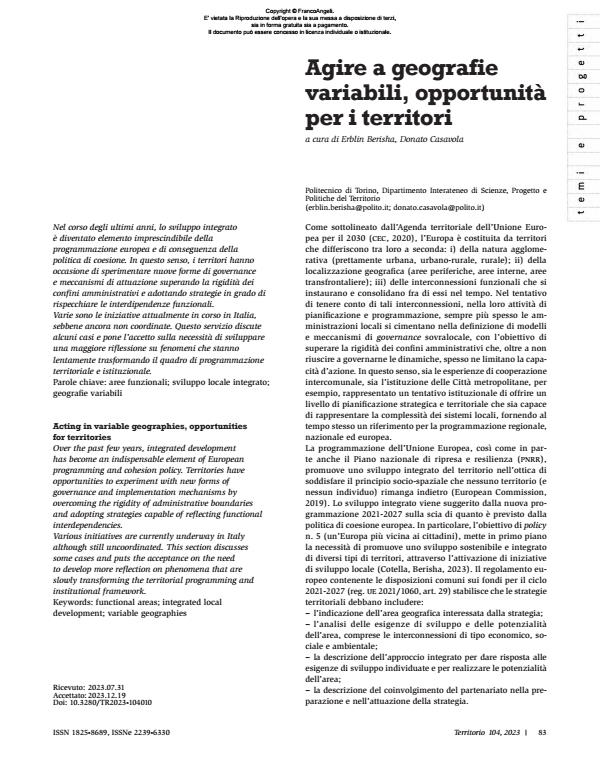Agire a geografie variabili, opportunità per i territori
Titolo Rivista TERRITORIO
Autori/Curatori Erblin Berisha, Donato Casavola
Anno di pubblicazione 2024 Fascicolo 2023/104
Lingua Italiano Numero pagine 3 P. 83-85 Dimensione file 113 KB
DOI 10.3280/TR2023-104010
Il DOI è il codice a barre della proprietà intellettuale: per saperne di più
clicca qui
Qui sotto puoi vedere in anteprima la prima pagina di questo articolo.
Se questo articolo ti interessa, lo puoi acquistare (e scaricare in formato pdf) seguendo le facili indicazioni per acquistare il download credit. Acquista Download Credits per scaricare questo Articolo in formato PDF

FrancoAngeli è membro della Publishers International Linking Association, Inc (PILA)associazione indipendente e non profit per facilitare (attraverso i servizi tecnologici implementati da CrossRef.org) l’accesso degli studiosi ai contenuti digitali nelle pubblicazioni professionali e scientifiche
Nel corso degli ultimi anni, lo sviluppo integrato è diventato elemento imprescindibile della programmazione europea e di conseguenza della politica di coesione. In questo senso, i territori hanno occasione di sperimentare nuove forme di governance e meccanismi di attuazione superando la rigidità dei confini amministrativi e adottando strategie in grado di rispecchiare le interdipendenze funzionali. Varie sono le iniziative attualmente in corso in Italia, sebbene ancora non coordinate. Questo servizio discute alcuni casi e pone l’accetto sulla necessità di sviluppare una maggiore riflessione su fenomeni che stanno lentamente trasformando il quadro di programmazione territoriale e istituzionale.
Parole chiave:aree funzionali; sviluppo locale integrato; geografie variabili
- La classificazione delle aree interne siciliane mediante la revisione dei criteri e degli indicatori SNAI Luigi Scrofani, Filippo Accordino, in RIVISTA GEOGRAFICA ITALIANA 2/2024 pp.63
DOI: 10.3280/rgioa2-2024oa17809 - Fragmented Spatial Planning:How the Differential Regional Legislative Framework Influences Land Consumption in Italy Donato Casavola, in Europa XXI /2025
DOI: 10.7163/Eu21.2024.47.9
Erblin Berisha, Donato Casavola, Agire a geografie variabili, opportunità per i territori in "TERRITORIO" 104/2023, pp 83-85, DOI: 10.3280/TR2023-104010